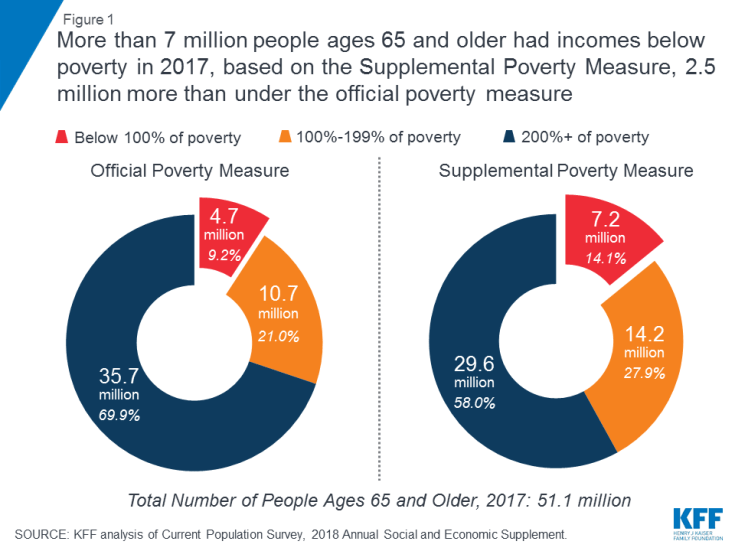How Many Seniors Live in Poverty?
Payments from Social Security and Supplemental Security Income have played a critical role in enhancing economic security and reducing poverty rates among people ages 65 and older. Yet many older adults have limited income and modest savings. In 2016, half of all people on Medicare had income less than $26,200 per person. This analysis provides current data on poverty rates among the 51.1 million older adults in the U.S., by age, gender, race/ethnicity, and health status and by state, as context for understanding the implications of potential changes to federal and state programs that help to bolster financial security among older adults.
The. U.S. Census Bureau reports two different measures of poverty: the official poverty measure and the Supplemental Poverty Measure (SPM). In 2017, the threshold for poverty under the official measure was $11,756 for an individual age 65 or older. Unlike the official measure, the SPM poverty thresholds vary by geographic area and homeownership status, and the SPM reflects financial resources and liabilities, including taxes, the value of in-kind benefits (e.g., food stamps), and out-of-pocket medical spending.
This analysis presents estimates of poverty under both poverty measures for adults ages 65 and older, based on data for 2017 and three-year averages (2015 to 2017). Estimates of poverty based on the SPM indicate that the number and share of older adults who are struggling financially are larger than when based on the official poverty measure. The difference is largely due to the fact that the SPM deducts out-of-pocket medical expenses from income, while the official poverty measure does not.
Key Findings
- Under the official poverty measure, 4.7 million adults ages 65 and older lived in poverty in 2017 (9.2%), but that number increases to 7.2 million (14.1%) based on the Supplemental Poverty Measure (Figure 1).
- More than 15 million older adults had incomes below 200% of poverty based on the official poverty measure in 2017 (30.1%), a number that increases to more than 21 million (42.0%) based on the SPM.
- The poverty rate among people ages 65 and older increases with age and is higher for women, blacks and Hispanics, and people in relatively poor health, under both the official poverty measure and the SPM.
- Nearly 3 million women ages 65 and older have incomes below poverty under the official poverty measure, but this number rises to more than 4 million under the SPM (based on three-year 2015-2017 averages). Among older men, 1.6 million live in poverty based on the official poverty measure, a number that increases to 2.7 million based on SPM.
- Across all states, the share of people living in poverty is higher under the SPM than under the official poverty measure. Based on the SPM, at least 15% of people ages 65 and older live in poverty in 9 states (CA, FL, HI, LA, MD, NJ, NM, TX, and VA) and D.C., as compared to just one state (LA) and D.C. based on the official poverty measure.

